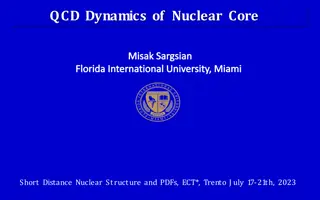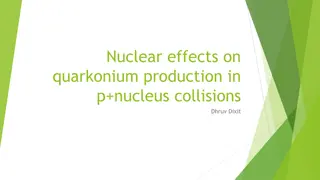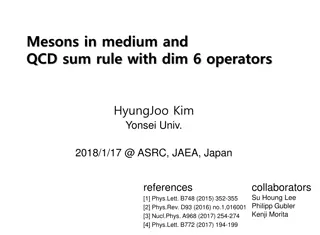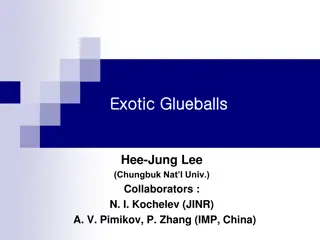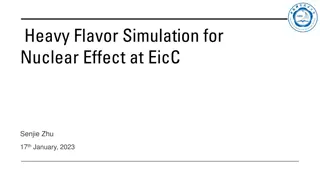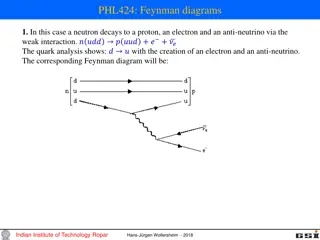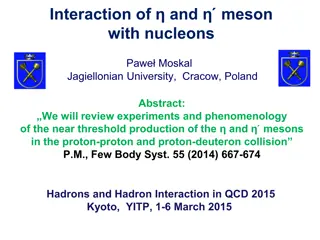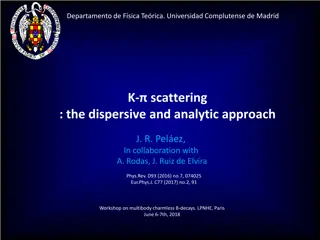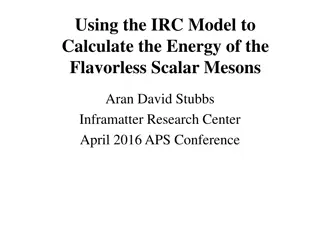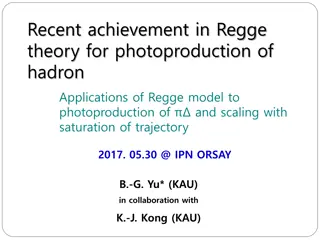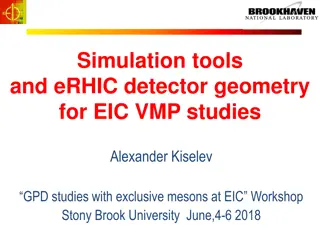Insights into Nuclear Core Dynamics and Structure
Exploring the dynamics of nuclear cores, this research delves into the intricacies of probing the NN repulsive core, modern NN potentials, and field theories of nucleons and mesons. The study encompasses the isospin dependence, non-nucleonic components, hidden color, and gluons within the nucleus, s
4 views • 63 slides
Insights into Quarkonium Production in Nuclear Collisions by Dhruv Dixit
Quarkonium mesons, such as Charmonium and Bottomonium, provide crucial information in understanding the effects of nuclear matter on their production in proton-nucleus collisions. These mesons, composed of quark-antiquark pairs, exhibit different behaviors in hot mediums, making them valuable probes
1 views • 11 slides
Mesons in Medium and QCD Sum Rule with Dim-6 Operators
Study of mesons in medium and their behavior using QCD sum rule with dim-6 operators, exploring mass shifts, broadening, and indicators of quark-gluon plasma. Specifically focuses on charmonium sequential dissociation and non-perturbative methods in QCD such as lattice QCD and Dyson-Schwinger equati
0 views • 27 slides
Exotic Glueballs and Hadrons in QCD Sum Rule
Delve into the world of exotic glueballs and hadrons through a review of QCD sum rule, investigation of light scalar mesons, and discussion on hadrons with unconventional quantum numbers. Learn about theoretical frameworks and calculations involving correlators, dispersion relations, Borel transform
5 views • 32 slides
Heavy Flavor Simulation for Nuclear Effect at EicC by Senjie Zhu
Fragmentation and hadronization differences in heavy flavor mesons compared to light mesons due to their stronger interaction with nuclear matter are explored in this study. The use of inclusive measurements at EicC is expected to provide insights into initial and final state effects in heavy ion co
4 views • 14 slides
Feynman Diagrams in Particle Physics
Exploring the concept of Feynman diagrams in particle physics through various examples, such as the decay of particles like neutrons, protons, electrons, anti-neutrinos, pi-mesons, and more. The diagrams illustrate the interactions between quarks and leptons, showcasing the transformations and decay
0 views • 14 slides
Interaction of Mesons with Nucleons in Proton Collisions
Review experiments and phenomenology of near-threshold production of η and mesons in proton-proton and proton-deuteron collisions. Explore challenges to theory in hadron interactions, mesic nuclei, and more.
1 views • 43 slides
Analytic Approach to K Scattering and Light Scalar Controversy
The study of K scattering presents challenges in understanding the nature of resonances like the K0*(800) and implications for strange spectroscopy. The light scalar controversy delves into the classification of scalar mesons and the emerging picture of a light scalar nonet. Analyzing data on K scat
0 views • 32 slides
Calculating Energy of Scalar Mesons Using IRC Model
Deriving the energy of flavorless scalar mesons through the IRC model offers valuable insights into particle physics. The research conducted by Aran David Stubbs at the Inframatter Research Center and presented at the APS Conference in April 2016 sheds light on this intriguing subject. The study pro
3 views • 12 slides
Recent Achievement in Regge Theory for Photoproduction of Hadron Applications
Recent breakthrough in Regge theory explores photoproduction of hadrons, applying the Regge model to understand scaling with trajectory saturation. The study delves into reaction mechanisms at high energies, introducing gauge and tensor meson exchanges. Analysis includes convergence and dominance of
2 views • 12 slides
Main features of the hadronic dark matter scenario
In this scenario presented by V. Kuksa and V. Beylin from Southern Federal University, various aspects of new quarks, fundamental interactions, heavy quark evolution, and quantum numbers of heavy hadrons are discussed. The presentation delves into the definition of mass of new quarks, effective inte
0 views • 22 slides
Hadron Spectroscopy program at JLAB @24 GeV
Discover the intriguing landscape of hadron spectroscopy at JLAB @ 24 GeV through exotic mesons and quarkonium-like resonances. Explore models of compact multiquark systems and the importance of photoproduction in understanding these phenomena.
3 views • 27 slides
Anonymous Questions and Answerable Topics
In the realm of physics research, the Anonymous Questions BFYS Workshop of 2008 sparked interest with thought-provoking inquiries on particle decays. Moving to 2019, the focus shifted to Answerable Questions, delving into topics like open charm mesons, invariant mass distributions, and the usage of
3 views • 25 slides
Double Cabibbo-Suppressed Decay in Charm Quarks
First discovery of double Cabibbo-suppressed decay in charm quarks, observed in D mesons, with significant signal observed in experiments like FOCUS and Belle. The weak decay amplitude reflects the structure and decay dynamics, challenging naive expectations. Analysis strategies involve precise bran
2 views • 22 slides
Advanced Simulation Tools and Detector Geometry for EIC Studies
Explore the utilization of simulation tools and eRHIC detector geometry for EIC VMP studies and GPD studies with exclusive mesons. Discover the BeAST main detector geometry, EicRoot framework, available functionality, and simulation usage options for comprehensive insights into experimental physics
1 views • 16 slides
K*-(892) Meson Production in High-Energy Physics Research
Explore the A-dependence in K*-(892) meson production in high-energy physics, based on experimental data from K-N interactions at the U-70 accelerator complex. Results from the SPASCHARM experiment by Nikita Kalugin shed light on the inclusive production of K*-(892) mesons for different targets. Eve
0 views • 15 slides
Weak Decays with Feynman Diagrams
Explore the world of weak decays in particle physics through the use of Feynman diagrams. Learn about the quarks involved, their transformations, and the creation of mesons and baryons. Dive into the intricate details of particles and their interactions within the realm of quantum mechanics.
0 views • 5 slides
NLO QCD Corrections in Inclusive Bc* Production
Discover the NLO QCD corrections in inclusive Bc* production within Z0 decays, including background information on Bc mesons, direct and indirect production methods, motivation behind the research, calculation divergences, and IR in one-loop diagrams. Explore the latest advancements and theoretical
4 views • 16 slides
Angular Distribution of Axial Vector Meson Decay
Explore the decay and angular distribution of (Axial) Vector mesons in different modes, aiming to distinguish between transverse and longitudinal modes through two-body decay distribution. Focus on K* and K1 as chiral partners. Efforts are made to differentiate mass differences in vacuum and medium
1 views • 17 slides
Meson Reconstruction in Xe Run at BM@N Experiment, NICA
Explore the reconstruction process of vector mesons in Xe run at BM@N Experiment, NICA. Learn about the significance of studying Κ*(892) and why it is interesting. Discover the data obtained, data processing procedures, and the efficiency results of the analysis.
2 views • 11 slides
New Discoveries in Hadronic Dark Matter Research
Explore the latest findings on hadronic dark matter, including new heavy hadrons as potential DM particles, experimental restrictions on new quarks, quantum numbers and quark structure of new hadrons, properties of new mesons, low-energy interactions with nucleons, and conclusions on the HDM scenari
2 views • 9 slides
Understanding Hadrons in Hot Dense Matter and Chiral Symmetry Restoration
Explore the behavior of hadrons in hot dense matter and the restoration of chiral symmetry in QCD vacuum amidst finite temperature nuclear matter scenarios. Delve into topics like vector mesons in flavor SU(3) symmetry, meson representation mixing, and chiral transformations of quark bilinears. Gain
0 views • 27 slides
